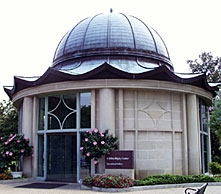On January 8, 2015, as part of the Theory and Practice Ring, Sharon Norquest, Conservator, National Air and Space Museum, Smithsonian Institution; Amelia Kile, Museum Specialist, National Air and Space Museum, Smithsonian Institution; and David Peters, Industrial Hygienist, Office of Safety Health and Environment Management, Smithsonian Institution, gave a talk.
Conservator Sharon Norquest and Amelia Kile of the National Air and Space Museum recently underwent a yearlong project in the preparation of radioactive objects for display. The museum has a large collection of early aircraft instrumentation and will be installing a case at the Steven F. Udvar-Hazy Center consisting of 86 of these objects, 60 of which contain radium paint. Though the radium paint no longer glows in the dark, it is still emitting radiation and any loose flakes and particles can be transferred by contact. This poses a hazard to those handling the objects and their storage materials. Sharon and Amelia collaborated with specialists to create a procedure for the safe handling and display of these instruments.
The project began after much pre-planning and included health and safety regulations, training, methods of identification, and setting up a dedicated work space. Depending on the amount of radioactive objects in one location, certain licenses and regulations need to be followed according to the U.S Nuclear Regulatory Commission. NASM is fortunate to have access to an industrial hygienist through SI who provided training and guidance on the proper handling and display of the collection. An important step was to find methods of measuring the radioactivity and subsequent exposure to personnel. Through proper training and use, Geiger counters can be used to measure the amount and type of radiation emitted. This was paired with an Alpha Beta Sample Counter which checks for surface contaminates by sampling paper disks pressed to the surface, and a Hidex 300 SL Liquid Scintillation Counter which analyses cotton swabs or paper wipes. NASM also has a dosimeter program that monitors the personal exposure to those who work in the presence of or handle radioactive materials.
A dedicated work space was set up for working on radioactive objects. Two portable HEPA-filtered fume hoods are clearly labeled for radioactive work exclusively and lined with Benchkote ®, a polyethylene coated cotton material used in the medical radiation and chemical industries. This material was also used to line carts and a photo area to prevent contamination, and all objects were contained in plastic bags in trays to prevent any flakes from spreading during handling. The treatment consisted mostly of consolidation of the paint, during which any tools used were clearly labeled and kept separately in a bag. For safety, all materials the objects come in contact with including the Benchkote, packaging materials, and swabs were treated as radium waste and checked for radioactivity, then properly stored until a dedicated contractor could dispose of the waste. Display case mockups were constructed to measure the emitted radiation with the objects, and the radiation was found to be below the public exposure limits when behind Plexiglas. The case will also have some airflow to prevent the build-up of radon levels inside.
The project created a successful protocol in the handling, conservation and display of the collection. The training and safety measures proved effective as the dosimeters worn throughout tested clean. Following are references to regulations in the storing, handling, and transportation of radioactive materials, as well as the Benchkote ® and instrumentation used during the project:
http://www.nrc.gov/ Website of U.S. Nuclear Regulatory Commission
http://www.nrc.gov/reading-rm/
http://www.gelifesciences.com/
http://www.hidex.com/products/
Summarized by: Dawn Wallace, Intern at the Smithsonian Institution National Museum of American History
